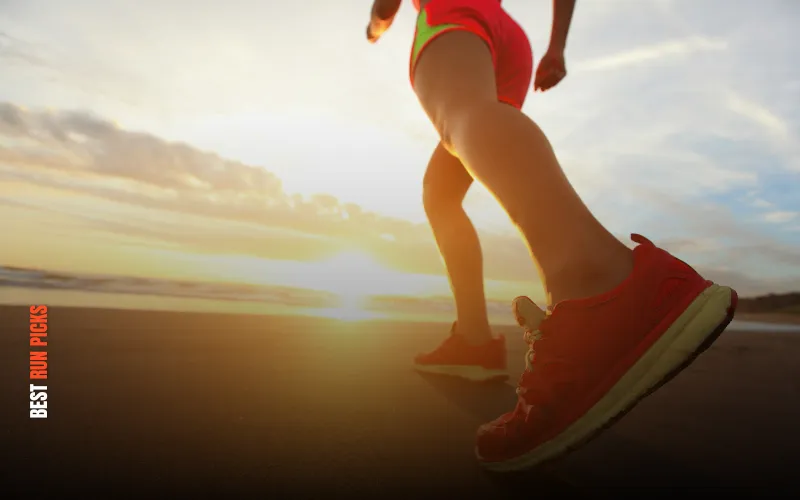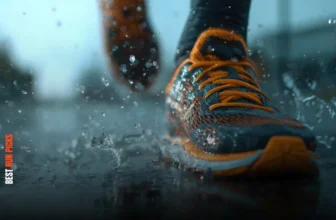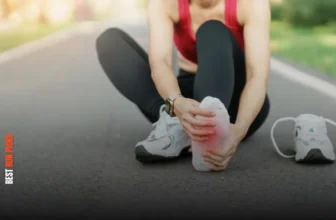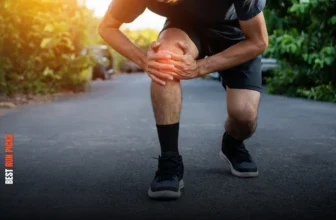
Finding the best stability running shoes for overpronators is the single most important step you can take toward a more comfortable and injury-free running journey. If you’ve ever felt that your feet roll inward too much with each step, the right pair of supportive running shoes can make a world of difference by guiding your stride. This guide is designed to be your straightforward resource, breaking down exactly what overpronation is and reviewing the top-rated shoes built to manage it, helping you run with confidence.
Top Picks At a Glance
In a hurry? Here are the 5 Best Stability Running Shoes for Overpronators:
- Brooks Adrenaline GTS 24: Men / Women
- HOKA Arahi 7: Men / Women
- Saucony Guide 17: Men / Women
- New Balance 880v14: Men / Women
- ASICS GT-2000 12: Men / Women
First, What Exactly Is Overpronation? (And a Simple Test)
So, what does “overpronation” actually mean? Let’s break it down simply. Pronation is the natural, slight inward roll of your foot as it moves from heel to toe during your stride. It’s your body’s built-in shock absorber. Overpronation happens when that foot rolls inward too far. Think of your foot’s arch collapsing a bit more than it should, which can sometimes put extra stress on your ankles, shins, and knees. This is especially common for runners who have lower arches or flat feet, and finding the right shoes for overpronation is key.
Not sure about your foot type? Here’s a quick and easy way to check at home.
The Simple “Wet Test”
- Pour a thin layer of water into a shallow pan.
- Get a piece of cardboard or a heavy paper bag you can stand on.
- Dip the sole of one foot into the water, getting it just wet enough to make a print.
- Step firmly onto the cardboard for a second or two, then step off.
- Take a look at the footprint you left behind.
- Normal Arch: If you see about half of your arch, you likely have a neutral stride.
- Flat Arch (Overpronation): If you see almost your entire footprint, your arch is likely collapsing inward. This is a classic sign of overpronation.
- High Arch: If you only see your heel, the ball of your foot, and a thin line on the outside, you have high arches.
If your footprint looks like the “Flat Arch” example, don’t worry! That’s exactly what stability running shoes are designed to help with.
The 5 Best Stability Running Shoes of 2025: Our Reviews
Alright, let’s get to the good stuff. We’ve personally researched and handpicked five of the most trusted stability running shoes on the market today. Here’s a closer look at what makes each one a great choice.
1. Brooks Adrenaline GTS 24
If there’s one shoe that’s consistently recommended to new runners needing support, it’s the Brooks Adrenaline. Think of it as the trusted, friendly veteran that has helped countless people start their running journey. Its key feature is the GuideRails support system. The best way to picture it is like bumpers in a bowling lane for your feet. They don’t interfere when your stride is on track, but if your foot starts to roll too far inward, they gently guide it back. It’s a smart, non-intrusive way to provide midsole support that helps protect your feet, shins, and knees, making it one of the most comfortable running shoes you can find.
- Who is this shoe really for? This is the perfect shoe for the new runner who doesn’t want to overthink it. If you want one single, dependable pair for your daily miles—from a short 2-mile jog to training for your first 5K—the Adrenaline is a fantastic and safe choice. It offers a “just right” balance of soft cushioning and reliable stability.
- Proven, reliable GuideRails support system is never intrusive.
- Excellent balance of soft cushioning and moderate stability.
- Trusted reputation as a go-to shoe for countless runners.
- Can feel less exciting or speedy compared to lighter options.
2. HOKA Arahi 7
HOKA is famous for its super-cushioned, almost cloud-like shoes, and the Arahi proves that you don’t have to sacrifice that plush feeling to get great stability. It cleverly solves a problem many runners have: wanting a soft ride without feeling wobbly. Instead of using a traditional, hard block of foam for support, the Arahi features HOKA’s J-Frame technology. Picture a “J”-shaped hook of slightly firmer foam that cradles your heel and runs along the inside of your foot. It acts as a subtle guide, preventing your foot from rolling too far inward.
- Who is this shoe really for? If you’ve tried other shoes for overpronation and found them too firm or rigid, the Arahi could be a game-changer. It’s an excellent choice for runners who want maximum cushioning for their daily miles or longer runs, all while keeping their overpronation gently in check. It’s for the runner who says, “I want support, but I refuse to give up comfort.”
- Exceptional cushioning provides fantastic joint comfort.
- J-Frame support feels smooth and unobtrusive, not stiff.
- Surprisingly lightweight for a max-cushion shoe.
- The high stack height isn’t for everyone; some runners prefer to feel more of the ground.
3. Saucony Guide 17
For years, stability running shoes had a reputation for being a bit stiff. The Saucony Guide 17 is leading the charge to change that perception. It uses Saucony’s CenterPath Technology. The best way to understand this is to imagine a wider base, combined with higher sidewalls of foam that your foot sits inside of, not just on top of. This creates an inherently stable platform that gently steers your foot forward. The result is stability that feels incredibly smooth and natural, complemented by the balanced and responsive PWRRUN foam.
- Who is this shoe really for? This shoe is for the runner who needs support but hates the feeling of traditional “support shoes.” If you want a daily trainer that feels fluid and almost like a neutral shoe, but still gives you confidence that your overpronation is managed, the Guide 17 is an outstanding choice.
- Modern stability feels very natural and almost disappears on the run.
- Smooth, comfortable, and responsive ride from the PWRRUN foam.
- Higher sidewalls create a very secure and centered feel.
- Runners used to a very firm medial post might find the support too subtle.
4. New Balance Fresh Foam X 880v14
The New Balance 880 is a legend. For years, it has been the go-to “workhorse” for runners needing reliable support. It uses a dual-layer midsole: the top layer is soft Fresh Foam X for comfort, while the bottom layer includes a new Stability Plane. This is essentially a supportive layer that works with the shoe’s geometry to create a dependable and secure base. This design gives you the best of both worlds: a soft landing followed by a very stable and guided push-off, making it one of the most reliable supportive running shoes available.
- Who is this shoe really for? This is the shoe for the runner who logs consistent miles, week in and week out. It’s built for durability and is perfect for anyone whose top priority is a trainer that feels incredibly secure and is built to last.
- Excellent durability and construction; this shoe is built to handle high mileage.
- Combination of soft foam and a stable base feels both comfortable and very secure.
- Reliable and consistent performance for daily training.
- It is one of the heavier shoes on this list and can feel a bit bulky.
5. ASICS GT-2000 12
The ASICS GT-2000 12 is a fantastic example of a shoe that delivers reliable stability without weighing you down. It’s a true jack-of-all-trades. It moves away from older support methods and uses a new 3D GUIDANCE SYSTEM. This system is all about the shoe’s smart geometry—a wider base and a flared heel all work together to guide your foot efficiently. Combined with ASICS’s lightweight and energetic FF BLAST PLUS cushioning, the GT-2000 12 feels surprisingly nimble and is one of the most comfortable running shoes for long distances.
- Who is this shoe really for? This shoe is perfect for the runner who wants one pair that can handle almost everything. It’s supportive enough for your daily miles, but light and responsive enough to pick up the pace if you feel like it.
- Lightweight and versatile feel, suitable for many different types of runs.
- Modern, adaptive stability feels very smooth and efficient.
- Energetic cushioning from FF BLAST PLUS foam.
- The fit can feel slightly narrower than other shoes on this list.
How to Choose the Right Shoes for Overpronation
After all the talk about technology, what’s the single most important factor? It’s simple: comfort. The best stability running shoes for overpronators on paper mean nothing if they don’t feel good on your foot. Your body is the ultimate judge.
- Trust Your First Impression: A good shoe should feel comfortable right out of the box.
- Get the Right Size (The Golden Rule): Always make sure you have about a thumb’s width of space between your longest toe and the very end of the shoe. Your feet naturally swell when you run.
- Focus on the Feel, Not Just the Tech: Let the overall feeling guide your decision. The goal of all this tech is to create a comfortable, supportive ride.
Conclusion: Your First Step to a More Stable Run
Navigating the world of supportive running shoes can feel complicated, but it doesn’t have to be a mystery. The goal isn’t to find the one “perfect” shoe, but to find the perfect shoe for you. Any of the options on our list of the best stability running shoes for overpronators is a fantastic starting point toward a more enjoyable and injury-free running journey. Happy running!
Frequently Asked Questions (FAQ)
1. Can I run in a neutral shoe if I overpronate?
While you can, it’s generally not recommended. Neutral shoes lack the specific support to counteract excessive inward roll, which can lead to discomfort or strain. Stability running shoes are designed to work with your body to make running feel better.
2. How long do stability running shoes typically last?
A good pair should last for approximately 300 to 500 miles. The exact lifespan depends on your body weight, running surfaces, and gait. It’s time for a new pair when the cushioning feels flat or you notice new aches and pains.
3. Are stability shoes also good for walking or everyday use?
Yes, absolutely! The same supportive features are incredibly beneficial for walking and standing for long periods, increasing comfort and reducing fatigue.
4. Will wearing stability shoes “fix” my overpronation?
Not exactly. Think of them as a tool, not a cure. They manage the motion and reduce stress while you are wearing them, much like eyeglasses help you see but don’t permanently change your vision.
5. Is all stability technology the same?
No, and that’s why personal comfort is key. Brands use different methods, from Brooks’ “GuideRails” to HOKA’s “J-Frame” and the wider, geometric bases of others. The best technology is the one that feels most natural on your foot.















